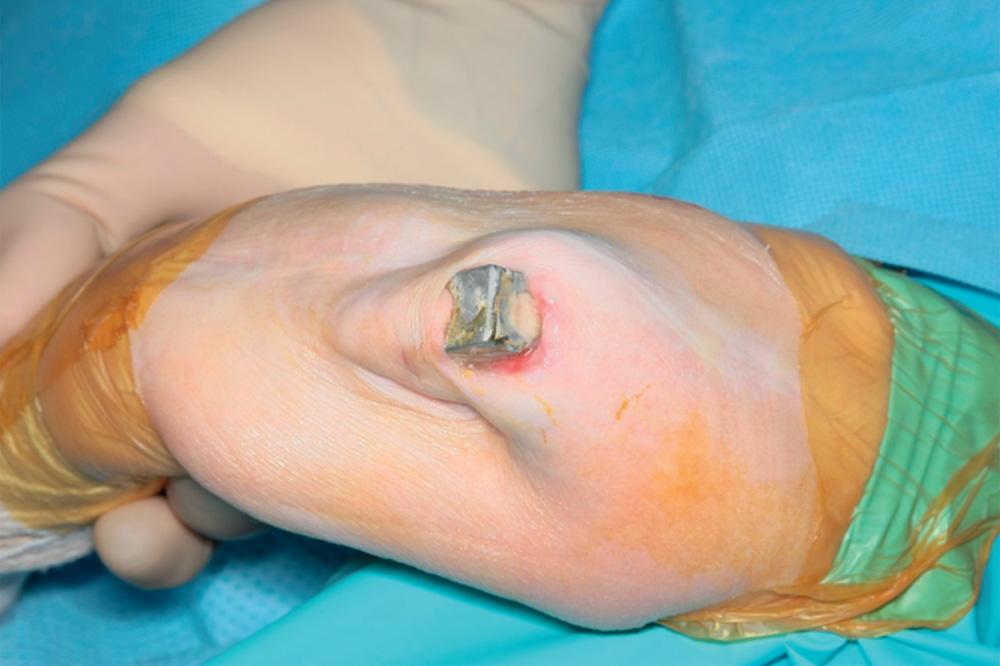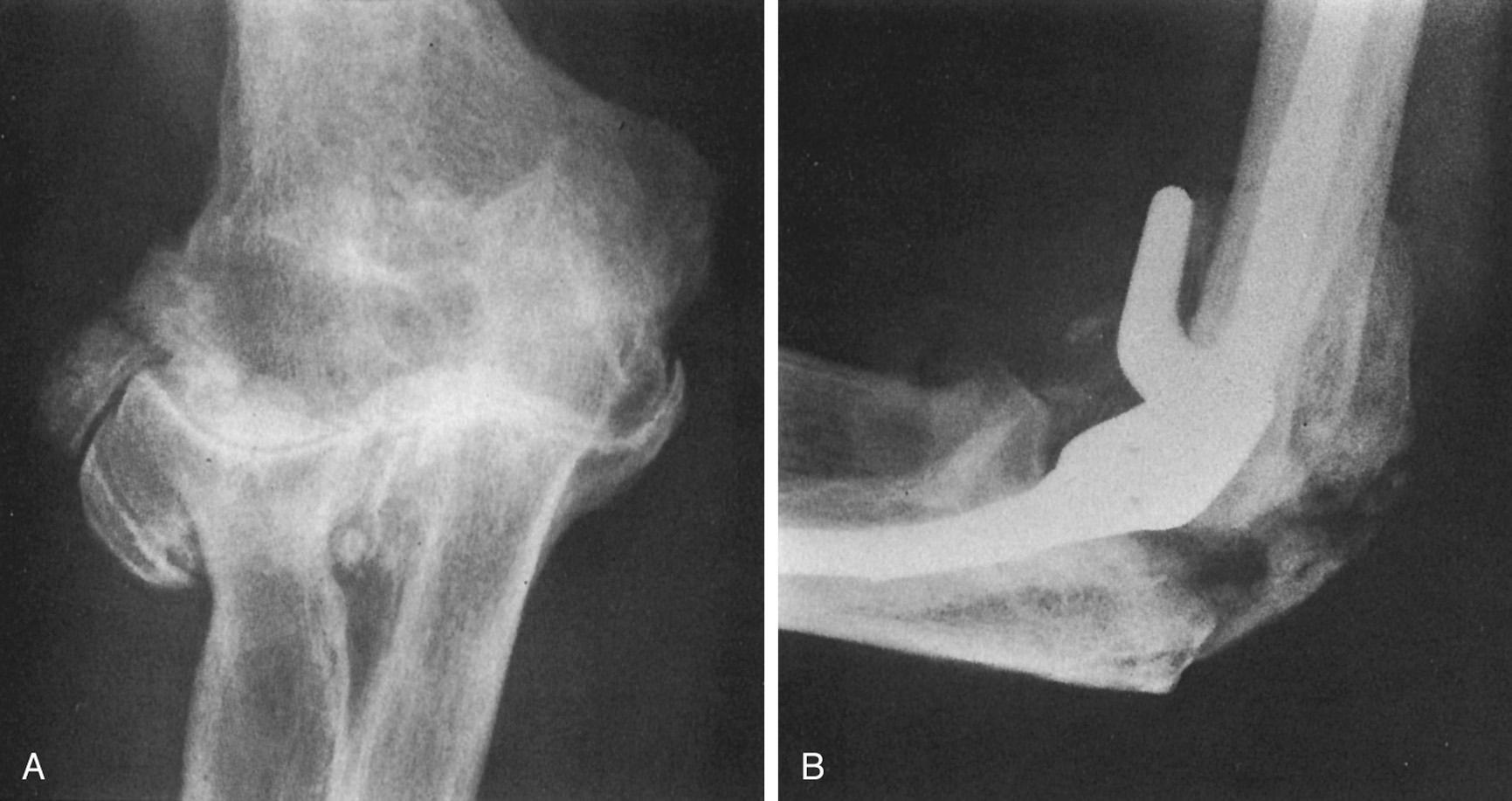Physical Address
304 North Cardinal St.
Dorchester Center, MA 02124
Complications after total elbow arthroplasty (TEA) have been widely publicized and are well recognized. An explanation for the high incidence of complications rests on the fact that the elbow is a complex joint that is poorly covered by soft tissue, is intimately traversed by a major nerve, and is vulnerable to host-compromising conditions, such as rheumatoid arthritis and previously operated on posttraumatic arthritis. A recent study demonstrated increased perioperative complications after TEA in patients with diabetes. Also obesity seems to be an independent risk factor associated with decreased elbow survival and mechanical failure.
Most of these complications neither require surgery nor adversely influence the ultimate result. Thus these problems might best be discussed according to their management and significance: (1) those that increase the morbidity but do not influence the outcome by requiring additional surgery, removal, or replacement of the implant and (2) those requiring additional surgery, including revision of the implant. Gschwend et al. in their systematic review of the world's literature from 1986 to 1992, discussed 828 procedures. Of these, 43% had complications ( Table 99.1 ).
| Complication | Incidence (%) a |
|---|---|
| Aseptic loosening | |
| Radiologic | 17.2 |
| Clinical | 6.4 |
| Infections | 8.1 |
| Ulnar nerve lesions | 10.4 |
| Instability | 7–19 |
| Disassembly | — |
| Dislocation | 4.3 |
| Subluxation | 2.2–6.5 |
| Intraoperative fractures | 3.2 |
| Fractures of prosthesis | 0.6 |
| Ectopic bone formation | — |
In the intervening years, there have been many advances in prosthetic design and surgical technique. For example, constrained devices have been eliminated owing to their high rate of loosening. Semiconstrained and unconstrained devices are being used now, and recently, hybrid designs that are unlinked but can be converted to a linked design have been developed. Variations in techniques such as triceps tendon dissection and repair, better cementation techniques, and routine antibiotic prophylaxis have emerged. The most recent comprehensive review of the literature to determine the complications associated with modern-day TEA comprised 38 studies that reported on 1981 total elbow replacements. The overall significant complication rate (requiring another surgical procedure or resulting in permanent clinical sequelae) after primary TEA was 27.9% ± 13.3%. The main complications included clinical loosening (4.8%; including symptomatic loosening or revision), instability including dislocation and symptomatic subluxation (3.8%), deep infection (2.5%), and ulnar nerve complications (2.5%) ( Table 99.2 ). The treatment of infection is discussed in detail in Chapter 101 , and loosening and periprosthetic fractures are dealt with in Chapters 106 and 109 . A detailed summary of the current literature regarding complications is given in Table 99.2 .
| Complication | Incidence (%) |
|---|---|
| Aseptic loosening (clinical) | 4.8 a |
| Aseptic loosening (clinical and radiographic) | |
| Linked designs | 15.9 b |
| Unlinked designs | 18.5 c |
| Infections | 2.5 a |
| Ulnar nerve lesions | 2.5 a |
| Disassembly | 4.2 a |
| Dislocation/subluxation | 3.8 a |
| Intraoperative fractures | 1.8 a |
| Fractures of prosthesis | 1.1 a |
| Ectopic bone formation | — |
The goal of elbow replacement surgery is to obtain the functional arc of 30 to 130 degrees of flexion. Those rheumatoid arthritic patients who have the ankylosing type of disease tend not to obtain the typical 30 to 130 degrees of flexion-extension after surgery. Therefore we attempt to treat this motion restriction with an aggressive capsular resection at the time of the implantation. If the anterior capsule is contracted, sufficient depth of insertion is most important. A trial reduction is essential to identify this potential problem so that it can be avoided. A static adjustable splint is often used to gain or maintain motion. Furthermore, a slight but consistently greater flexion contracture is observed with resurfacing designs (see Chapter 105 ).
Nonseptic wounds are much less a problem today than they used to be (5% incidence previously reported).
Wound healing problems are best avoided. At the Mayo Clinic we avoid the use of the Steri-Drape after skin preparation with iodinated solutions, especially in patients with rheumatoid arthritis. I also use a straight incision just medial to the tip of the olecranon and carefully cauterize vessels during surgery. The elbow is placed in full extension with a compression/cryotherapy device (Cryocuff Aircast, DJO, Vista, CA), which is used if there is concern about excessive swelling. If the wound remains tenuous at 1 week or 10 days, we do not hesitate to place the patient's elbow in a cast or anterior splint for 10 to 14 days and then reassess the wound. If severe wound necrosis occurs or the implant extrudes through the skin ( Fig. 99.1 ), surgical treatment may involve special soft tissue coverage, which is discussed in Chapter 58 .

In patients with rheumatoid arthritis or a joint that has been subjected to previous surgery, the ulnar nerve is particularly vulnerable. The incidence of ulnar nerve involvement has been reported as 2% to 26%, and the severity ranges from profound neuropathy in less than 5% of patients to transient paresthesias in as many as 25% of patients. Implicated causes are excessive traction, perineural or epineural hematoma, direct mechanical pressure during the procedure, and irritation by the bandage or from swelling. The possibility of thermal damage from juxtaposed methylmethacrylate may be considered, as well as devitalization during the translocation procedure. The review by Gschwend et al. of the experience in the literature from 1986 to 1992 reveals an incidence of approximately 10% after almost 900 procedures. We have found a 3% rate for subjective symptoms after 700 procedures at the Mayo Clinic. No patient had motor weakness.
In our review of the literature in the last decade, the rate of ulnar neuropathy was found to be 2.5%. In light of the association between TEA and ulnar neuropathy, controversy persists regarding the need for routine ulnar nerve transposition during surgery. Some of the cited advantages of routine nerve transposition include protection of the nerve in a safe location during the exposure and elbow manipulation, decreasing the stretching forces on the nerve with elbow motion postoperatively, and reducing the compression on the nerve in the cubital tunnel. Some of the disadvantages include injury to the blood supply to the nerve and mechanical injury during the dissection. In our metaanalysis, the rates of significant ulnar neuropathy were compared between the studies that routinely transposed the nerve and the ones that selectively transposed the nerve. The results showed that routine ulnar nerve transposition resulted in lower rates of significant ulnar neuropathy (2.1% ± 3.5%) compared with the studies in which the nerve was not mobilized routinely (4.3% ± 5.2%) ( p = .17). Even though this difference was not statistically significant, it is believed to be clinically significant. The overall rate of significant ulnar neuropathy was only 2.5%, making it very difficult to detect a statistically significant difference between routine and nonroutine ulnar nerve transposition. This subject is currently being formally reevaluated as we feel the complication is more frequent than is currently reported.
If profound motor weakness is present immediately after surgery and uncertainty about the neural status exists, the nerve should be explored. We have not yet had to do this. Our technique translocates the nerve; thus little might be gained by another procedure. Sensory defects, especially if they are incomplete, usually resolve spontaneously, and therefore reexploration is not warranted.
Triceps insufficiency is probably common, but it is not reported very often. The poor quality of the triceps tendon in patients with rheumatoid arthritis is well recognized, but only less than 3% of patients with rheumatoid arthritis have been recognized as having significant triceps insufficiency. The Mayo approach and its modification were developed because of this problem. We have documented 13 of 700 (2%) since 1981. In our literature review of the last decade, triceps-related complications were analyzed after the three most common triceps dissection techniques. No triceps-related complications were found with the V-shaped tongue approach at the musculotendinous junction. Triceps reflection, with or without extraarticular wafers of the olecranon, was associated with a complication rate of 2.3% ± 4.6%, whereas the triceps split, either with or without extraarticular wafers of the olecranon, was associated with a complication rate of 6.2% ± 14.8%. The difference in complication rates among the three approaches was not statistically significant.
A recent study looked at the lateral paraolecranon approach for TEA. This approach avoids triceps tendon detachment from and repair to the olecranon. This resulted in reduced risk of triceps insufficiency while maintaining better extension strength compared with the triceps-splitting approach.
As with ulnar neuropathy, we feel that triceps deficiencies have been underreported and underestimated in the prior literature on the subject.
Triceps weakness is expected after any exposure that violates the extensor mechanism. Today, most exposures reflect rather than transect the attachment. Reattachment is with a heavy nonabsorbable No. 2 or No. 5 suture ( Fig. 99.2 ).

Become a Clinical Tree membership for Full access and enjoy Unlimited articles
If you are a member. Log in here